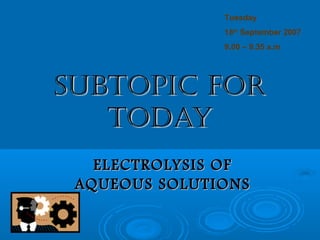
Electrolysis of Aqueous Solutions
- 1. Tuesday 18th September 2007 9.00 – 9.35 a.m SUBTOPIC FOR TODAY ELECTROLYSIS OF AQUEOUS SOLUTIONS
- 2. ELECTROLYSIS OF AQUEOUS SOLUTIONS What you understand about electrolysis from the previous lesson?
- 3. Can anyone give an idea what is aqueous solutions? Aqueous solution is a solution produced when the compound is dissolved in water. It contains: a. anions and cations of the compound. b. hydrogen ions, H+ and hydroxide ions, OH- from the partial dissociation of water molecules.
- 4. What is the different between electrolysis in molten compound and electrolysis in aqueous solutions? In molten compound it only contain anion and cation of the compound. But in aqueous solution it contain anion, cation and two types of ions come from water.
- 5. Electrolysis of copper (II) sulphate solution A Anode (Carbon) Cathode (Carbon) H+ H+ SO42- SO42- Cu2+ Electrolyte Cu2+ OH- - OH (CuSO4)
- 6. Example: Electrolysis of Aqueous NaCl Cations Anions Na+ Cl- H+ OH-
- 7. Experiment 6.3: Electrolysis of Aqueous Solutions The electrolytic cell is filled with 0.1 M copper (II) sulphate solution until it is half full. The apparatus is set up as shown in Figure 6.5. The switch is turn on to allow electricity to pass through the electrolyte for a few minutes. What happen in the anode and the cathode is observed. Any gas release is test using a glowing splinter and a lighted splinter. Steps 1 to 5 are repeat using 0.1 M sulphuric acid. All observation is recorded.
- 8. Figure 6.5 Test tube Electrolyte Carbon electrodes Ammeter Switch A Battery
- 9. Result Electrolyte Ions present in Observation electrolyte Anode Cathode Copper (II) H+, OH-, Cu2+, A gas is An orange liberated. This coloured sulphate SO42- gas ignites a deposit is glowing formed. splinter. Sulphuric H+, OH-, SO42- Colourless Colourless gas is gas is acid liberated. The liberated. A glowing pop sound is splinter burst heard when into flame the gas is when it is tested with the tested with the burning gas. splinter.
- 10. ACTIVITY 1
- 11. Factors Affecting Electrolysis of an Aqueous Solution
- 12. Position of the elements in the electrochemical series. For positive ions, the facility of discharge decrease in going from those least electropositive to those most electropositive. For example, if both copper and hydrogen ions are present in solution, it will be the copper ions which take electrons from the cathode to become copper atoms.
- 13. Effect of the electrode on the product of the electrolysis. This is not as important as either of the other two factors, except in certain cases. For example in the electrolysis of molten sodium chloride using a mercury cathode, sodium ions are discharged in preference to hydrogen ions which are lower in the series.
- 14. The effects of concentration of electrolytes. Irrespective of the position of the ions in the electrochemical series, there is a tendency to promote the discharge of the most concentrated ion present. For example, in concentrated sodium chloride solution (i.e. brine) , the two cations present are the chlorine ion and the hydroxyl ion. Although the hydroxyl ion is more easily oxidized than the chlorine ion, it is the chlorine ion which will be discharged because its concentration is much greater than that of the hydroxyl ion.
- 15. Electrochemical Series Cation Anion K+ F- Na2+ SO42- Easier to discharge Ca2+ NO3- Mg2+ Cl- Al3+ Br- Zn2+ I- Fe2+ OH- Sn2+ Pb2+ H+ Cu2+ Ag+
- 16. The reactivity increases down the series. That is the ions at the bottom of the series are chosen instead of ions at the higher up positions. In an aqueous solution of an ionic salt, OH - are usually discharged to form oxygen.
- 17. Electrolysis of copper (II) sulphate solution A Anode (Carbon) Cathode (Carbon) H+ H+ SO42- SO42- Cu2+ Electrolyte Cu2+ OH- - OH (CuSO4)
- 18. Example Electrolysis of copper (II) sulphate solution The ions present in this solution are: Cu2+, H+, SO42-, OH-. Half Equation: at anode: 4OH- (aq) 2H2O(l) + O2 (g) + 4e- At cathode: Cu2+(aq) + 2e- Cu (s)
- 19. ACTIVITY 2
- 20. END OF LESSON
